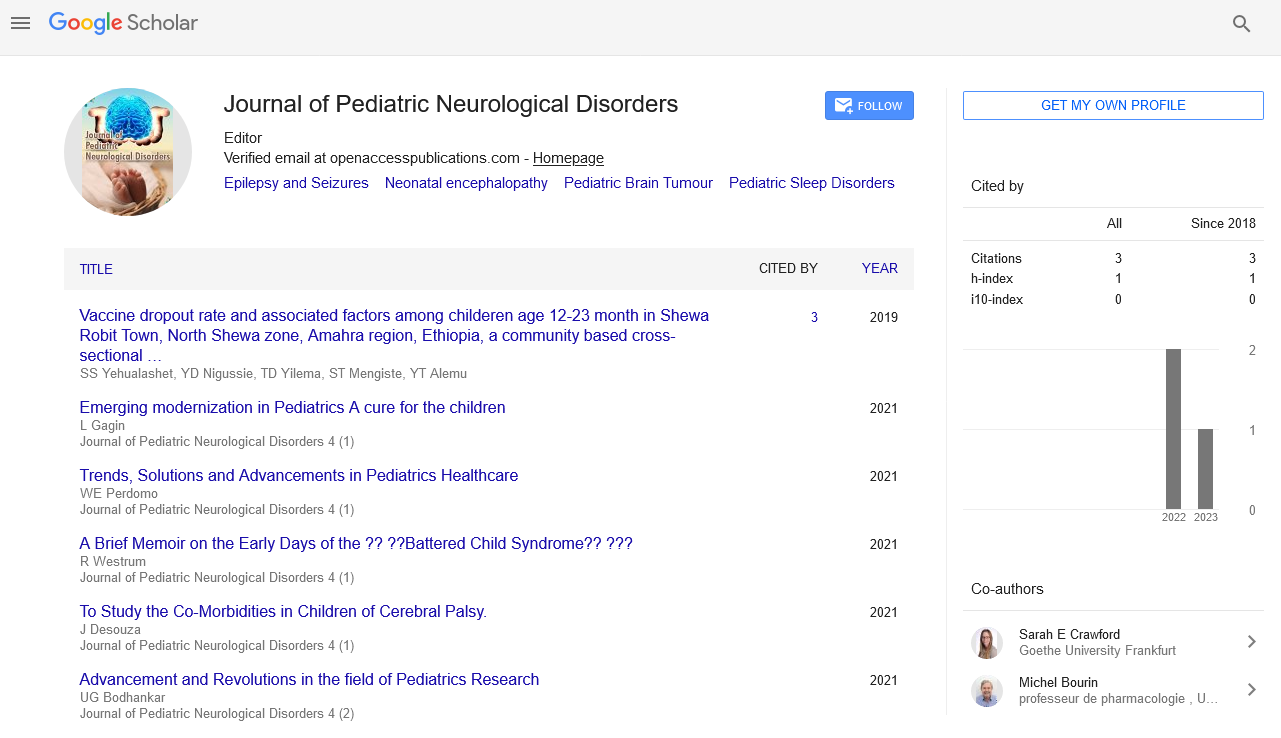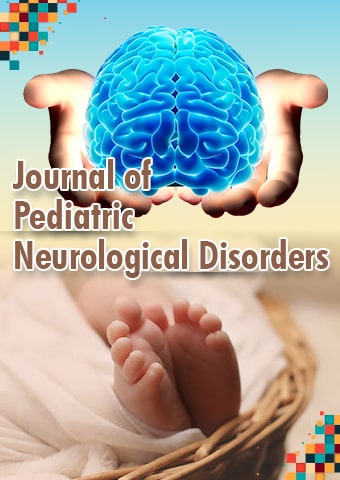Mini Review - Journal of Pediatric Neurological Disorders (2023) Volume 6, Issue 3
Strategies and Obstacles to Avoiding Pediatric Hydrocephalus Cerebrospinal Fluid Shunting
Kettle Shannon*
Department of Neuroscience, University of Milan
Department of Neuroscience, University of Milan
E-mail: kettle1@um.ac.it
Received: 01-June-2023, Manuscript No. pnn-23-103767; Editor assigned: 05-June-2023, PreQC No. pnn-23- 103767(PQ); Reviewed: 19- June- 2023, QC No. pnn-23-103767; Revised: 21-Apr-2023, Manuscript No. pnn-23-103767; Published: 28-June-2023, DOI: 10.37532/ pnn.2023.6(3).60-62
Abstract
Not only does treatment for pediatric hydrocephalus aim to shrink the enlarged ventricle morphologically, but it also aims to establish an intracranial environment that fosters the best neurocognitive development and addresses a variety of treatment-related issues over time. Even though there are many different causes of hydrocephalus, the ventricular peritoneal shunt has been used as the standard of care for decades. However, complications like shunt infection and malfunction cannot be avoided; the anticipation of neurological capability is seriously impacted by such factors, particularly in babies and newborn children. Treatment ideas to avoid shunting have been tried in recent years, mostly in pediatric cases. A new therapeutic concept for post intraventricular hemorrhagic hydrocephalus in preterm infants is documented, as is the current role of neuroendoscopic third ventriculostomy for noncommunicating hydrocephalus. Treatment options must be developed in order to avoid the need for a shunt and ensure that children with hydrocephalus have favorable neurodevelopmental outcomes.
Keywords
Pediatric hydrocephalous • Enlarge ventricle • Intra cranial environment • Neurocognitive development • Intra ventricular hemorrhagic hydrocephalous • Non communicating hydrocephalous
Introduction
The most prevalent condition in pediatric neurosurgery, hydrocephalus necessitates surgical treatment in the majority of cases. The goal of treatment for hydrocephalus in children is not only to keep intracranial pressure within the normal physiological range, but also to create an intracranial environment that encourages good cognitive development. Moreover, different related issues should be appropriately treated over an extensive stretch post surgery. Hydrocephalus can be caused by a variety of illnesses, but almost all of them can be treated with surgery to install a ventriculo-peritoneal (VP) shunt. 1) Although shunt-related complications like shunt dysfunction and shunt infection are unavoidable, the neurological functional outcome is severely impacted by these complications, particularly in newborns and infants, VP shunt has been the standard treatment for several decades. In this paper, the current practices and unsolved issues in pediatric hydrocephalus are discussed. In recent years, new treatment concepts have attempted to prevent the introduction of a VP shunt, primarily in pediatric cases. All participants gave their informed consent, and the research ethics committee's guidelines were followed during the study [1, 2].
Description
ETV's efficacy as a treatment for hydrocephalus
The pathophysiology of hydrocephalus must be well understood in order to successfully treat pediatric hydrocephalus with ETV and avoid the need for VP shunt placement. For decades, three aspects have been classically considered: the production, circulation, and absorption of Cerebrospinal Fluid (CSF). Nevertheless, the hydrodynamic theory for hydrocephalus has revealed more complex pathologies in recent research. Thomale simplified the concept using seven CSF dynamics factors in the most recent study. The seven factors, which include pulsatility, CSF production, major and minor CSF pathways, CSF absorption, venous outflow, and respiration, may overlap depending on the individual hydrocephalic condition.The effect of ETV is to resolve issues pertaining to pulsatility and major CSF pathways. Specifically, ETV reduces transmantle pulsatile stress by increasing the compliance of the ventricular wall and restores CSF communication between the ventricle and the subarachnoid space [3].
Factors that lower ETV's success rate
Infants under six months of age, post-infection, and Intra Ventricular Hemorrhage (IVH) are the factors that reduce the success rate of ETV. It is essential to comprehend the reasons behind ETV's failure. It is common knowledge that cerebral aqueduct stenosis and obstruction of the fourth ventricle's outlet prevent noncommunicating hydrocephalus in infants from responding to ETV as effectively as it does in older children. The soft capillary cavity, which has an open fontanelle and allows for elastic volume changes in the cranial compartment, is the most obvious anatomical difference in infancy. Unfortunately, this cavity disappears in the first year of life. Additionally, since arachnoid granulation is absent in infancy, CSF absorption is primarily responsible for the minor pathway. As previously mentioned, ETV restores transmantle pulsatile stress and restores CSF communication; As a result, early childhood is a unique time when neither can be achieved [4].
Functional outcomes of pediatric hydrocephalus treated with ETV
While discussing the success or failure of ETV, it makes no sense to merely discuss the suppression of the progression of ventricular enlargement without the need for additional treatment because the treatment for pediatric hydrocephalus aims to create an intracranial environment that promotes the best neurocognitive development. When compared to a VP shunt, ETV typically results in a smaller and more gradual decrease in ventricular size. In addition, it is not uncommon for morphological changes to cease with a slight decrease in the size of the ventricular chambers. This makes a big difference from the VP shunt treatment. However, it is more important to find out if good neurocognitive function can be achieved in such a situation. In a study comparing quality of life after ETV and VP shunt, treatment by ETV was associated with significantly higher scores in physical, cognitive, and socialemotional health, even after controlling for any confounders. After multivariable adjustment, there was also no significant difference in any outcome measure. After adjusting for prognostic factors, the researchers came to the conclusion that treatment with ETV or CSF shunts did not appear to be associated with a significant difference in quality of life outcomes. ETV patients had more cerebral aqueduct shunts and brain tumors than VP shunt patients, who had Myelomeningocele (MMC) and prematurity IVH; the average age at the time of surgery was 66.9 months for ETV and 17 months for VP shunt; this ought to be thought about while inspecting the useful treatment results [5].
There are currently no large-scale reports of long-term functional prognosis in various diseases other than aqueduct stenosis.46) In a randomized study limited to patients with aqueduct stenosis who underwent surgery at younger than 24 months, the overall health and quality of life were found to be high, with no significant differences between those treated initially with ETV or VP shunts. Therefore, only in situations with high ETVSS should ETV be actively performed [6].
How can we lessen the damage to the white matter in the periventricular region and improve neurodevelopment?
Periventricular white matter damage causes permanent neurological deficits, but mortality rates in preterm infants with high-grade IVH have been declining, with little improvement in neurodevelopmental outcomes. Indeed, white matter degeneration has a complex pathophysiology. White matter damage is correlated with numerous unfavorable factors. Additionally, the hematoma's damaging factors and its lysates continue to be significant. Free radicals may come from free iron, and the accumulation of free iron for months in an immature brain may also play a role in the progression of white matter damage. White matter injury and subsequent cerebral palsy have also been linked to proinflammatory cytokines. Because of pressure, distortion, free radical damage, and inflammation, IVH and PIVHH cause progressive periventricular white matter injury over several months. In theory, the VP shunt should be delayed until the newborn reaches a weight of 1800 to 2000 g. During that time, PIVHH causes periventricular white matter damage in a steady and gradual manner. In fragile preterm infants, VP shunt surgery and its management frequently result in challenging complications. A shunt infection almost certainly results in severe brain damage. The isolated fourth ventricle is recognized as a unique and difficult-to-treat complication, and shunt-related complications are also common [7, 8].
The following five therapeutic concepts provide a summary of the key points that emerged from the investigation into ways to enhance the neurodevelopmental outcome: Control of intracranial pressure throughout the early stages of PIVHH; 2) immediate review of the volume of the brain mantle; in other words, restore the brain's morphology; 3) prompt washout and dissolution of the hematoma; 4) the suppression of inflammatory cytokines and free radicals; and 5) preventing the placement of a permanent VP shunt. White matter damage around the ventricles will be reduced by these treatment approaches [9, 10].
Conclusion
For a number of decades, VP shunts have been widely used as a standard treatment for pediatric hydrocephalus. Despite this, there is a significant risk of shunt-related complications, and it is hoped that treatment options will be developed to prevent shunt placement and improve neurodevelopment. Although the ETV for non communicating hydrocephalus has already been established, there are still problems that need to be resolved once more. Recent reports suggest that fibrin lytic therapy and NEL might be alternative promising treatment concepts for PIVHH in premature infants, despite the fact that the development of a treatment for PIVHH is still in the early stages.
References
- Hanak BW, Bonow RH, Harris CA et al. Cerebrospinal fluid shunting complications in children. Pediatr Neurosurg .52, 381-400 (2017).
- Kulkarni AV, Drake JM, Kestle JR et al. Predicting who will benefit from endoscopic third ventriculostomy compared with shunt insertion in childhood hydrocephalus using the ETV Success Score. J Neurosurg Pediatr. 6, 310-315 (2010).
- Kulkarni AV, Riva Cambrin J, Rozzelle CJ et al. Endoscopic third ventriculostomy and choroid plexus cauterization in infant hydrocephalus: a prospective study by the Hydrocephalus Clinical Research Network. J Neurosurg Pediatr. 21, 214-223 (2018).
- Acakpo Satchivi L, Shannon CN et al. Death in shunted hydrocephalic children: a follow-up study. Childs Nerv Syst. 24, 197-201 (2008).
- Tuli S, Tuli J, Drake J et al. Predictors of death in pediatric patients requiring cerebrospinal fluid shunts. J Neurosurg. 100, 442-446 (2004).
- Hari Raj A, Malthaner LQ, Shi J et al. United States emergency department visits for children with cerebrospinal fluid shunts. J Neurosurg Pediatr. 27, 23-29 (2020).
- Tamber MS, Klimo P Jr, Mazzola CA et al. Pediatric Hydrocephalus Systematic Review and Evidence-Based Guidelines Task Force: Pediatric hydrocephalus: systematic literature review and evidence-based guidelines. Part 8: Management of cerebrospinal fluid shunts infection. J Neurosurg Pediatr. 14, 60-71 (2014).
- Cusimano MD, Meffe FM, Gentili F et al. Ventriculoperitoneal shunt malfunction during pregnancy. Neurosurgery. 27, 969-971 (1990).
- Ritsch MJ, Doerner L, Kienke S et al. Hydrocephalus in children with posterior fossa tumors: role of endoscopic third ventriculostomy. J Neurosurg. 103, 40-42 (2005).
- Kleinman G, Sutherling W, Martinez M et al. Malfunction of ventriculo peritoneal shunts during pregnancy. Obstet Gynecol. 61, 753-754 (1983).
Indexed at, Crossref Google Scholar
Indexed at, Crossref, Google Scholar
Indexed at, Crossref, Google Scholar
Indexed at, Crossref, Google Scholar
Indexed at, Crossref, Google Scholar
Indexed at, Crossref, Google Scholar
Indexed at, Crossref, Google Scholar
Indexed at, Crossref, Google Scholar
Indexed at, Crossref, Google Scholar

